20 More Than Glass
Posted by Christine on Nov 5, 2014 in Ireland | 2 comments
The first story in James Joyce’s Dubliners begins with a child standing in the street, looking in a window to the room where a priest he knows is dying; the boy studies “the lighted square of window: and night after night I had found it lighted inthe same way, faintly and evenly.* In one of the most beautiful passages of prose every written, the final story in the collection, “The Dead,” ends with the main character Gabriel Conroy looking out the window of a Dublin hotel to the snow falling on the street below,“falling faintly through the universe and faintly falling, like the descent of their last end, upon all the living and the dead.”** Joyce’s stories are filled with windows and characters looking in and looking out. We readers are, of course, looking in the window at the private lives of the characters in each story and looking out on the Dublin of Joyce’s day from these vantage points.
The window is an apt metaphor for fiction—and for nonfiction—both of which frame lives in stories and see into lives and out into the world. As Henry James wrote in the preface to Portait of Lady, “The house of fiction has in short not one window, but a million — a number of possible windows not to be reckoned, rather; every one of which has been pierced, or is still pierceable, in its vast front, by the need of the individual vision and by the pressure of the individual will.”As James suggests, windows may in one sense be confined spaces, but they are also sites of endless possibility, but they must be “pierced,” an action far more forceful and intentional than a “gaze” or an accidental “glance.” Should I have called this blog “The Piercing Individual Vision from Here”? Probably not. Think of “view” as a considered and purposeful act.
For a long time my photographs of Ireland and other places have included a remarkable number of window pictures. A quick review of the albums on my computer yielded over forty such photos in the last three years. Most of them are taken from the inside looking out, though I also have quite a few taken from the outside looking in, and many of them are rather poor quality; working with a subject that emanates light while standing in a darkened room is a photographic feat I have not yet mastered. Sometimes that lack of knowledge yields interesting results, though—strange glows and eerie shadows.
I’m not the only one interested in windows. It would be easy to put together an exhibition of window paintings. From Vermeer to Andrew Wyeth, many artists have taken up this challenge, so many that I think it must be a thing, like a painting a still-life or drawing a nude, something artists must do to learn their craft or perhaps to prove it. And I can think of quite a few writers who have written about windows, among them Keats and his “magic casements,” George Eliot (remember Dorothea looking out of the window at Casaubon’s house in Middlemarch, yearning for something more?), Henry James, and Louis MacNeice, the Belfast poet, and his wonderful poem about “the drunkenness of things being various,” “Snow.” In Belfast on the Malone Road you can still see the house where MacNeice lived and the “great bay window” that probably inspired this poem.
Snow
The room was suddenly rich and the great bay-window was
Spawning snow and pink roses against it
Soundlessly collateral and incompatible:
World is suddener than we fancy it.
World is crazier and more of it than we think,
Incorrigibly plural. I peel and portion
A tangerine and spit the pips and feel
The drunkenness of things being various.
And the fire flames with a bubbling sound for world
Is more spiteful and gay than one supposes –
On the tongue on the eyes on the ears in the palms of one’s hands –
There is more than glass between the snow and the huge roses.
There is more than glass between the interior and the exterior, between the two worlds that come together in the frame.
Thinking about my own window obsession, I love the way a window frames the picture, giving it a temporary structure, and if the window is paned, marks it into sections or pictures within pictures, almost doing the work for the photographer or painter or storyteller. I’m one of those people who has to work near a window, if possible, especially if I’m reading or writing, so I want to know what other people see from their working windows.
When I visit a house where someone famous lived, that is one of the photos I try to take. James Joyce lived at 60 Shelbourne Road—very near where I live here in Dublin—in 1904. On June 16 of that year, he set out from the house and ended up meeting his future wife Nora Barnacle and setting his novel Ulysses on June 16, 1904, a day that has come to be called Bloomsday (after the main character, Leopold Bloom) here in Ireland and around the world. What was he thinking when, later that night, he sat by his upstairs window looking out onto the lighted street? William Butler Yeats at Thoor Ballylee, the lady of the house in her drawing room at Muckross House (photo at the top of this page), the verger in the church at Killough, the kitchen staff at Strokestown House in County Longford—what did they see from their windows? Did looking out the window make them feel trapped or help them fly away, as Keats imagines, if only for a moment?
For all of these reasons and more, painters, photographers, novelists, poets, and bloggers stand at the window, drawn to these in-between places where they can look out and look in to the worlds brought together at the sill, the “incorrigibly plural” realities refracted in the “more than glass.”
*“The Sisters” from Dubliners by James Joyce There was no hope for him this time: it was the third stroke. Night after night I had passed the house (it was vacation time) and studied the lighted square of window: and night after night I had found it lighted in the same way, faintly and evenly. If he was dead, I thought, I would see the reflection of candles on the darkened blind for I knew that two candles must be set at the head of a corpse. He had often said to me: “I am not long for this world,” and I had thought his words idle. Now I knew they were true. Every night as I gazed up at the window I said softly to myself the word paralysis. It had always sounded strangely in my ears, like the word gnomon in the Euclid and the word simony in the Catechism. But now it sounded to me like the name of some maleficent and sinful being. It filled me with fear, and yet I longed to be nearer to it and to look upon its deadly work.
**“The Dead” from Dubliners by James Joyce A few light taps upon the pane made him turn to the window. It had begun to snow again. He watched sleepily the flakes, silver and dark, falling obliquely against the lamplight. The time had come for him to set out on his journey westward. Yes, the newspapers were right: snow was general all over Ireland. It was falling on every part of the dark central plain, on the treeless hills, falling softly upon the Bog of Allen and, farther westward, softly falling into the dark mutinous Shannon waves. It was falling, too, upon every part of the lonely churchyard on the hill where Michael Furey lay buried. It lay thickly drifted on the crooked crosses and headstones, on the spears of the little gate, on the barren thorns. His soul swooned slowly as he heard the snow falling faintly through the universe and faintly falling, like the descent of their last end, upon all the living and the dead.

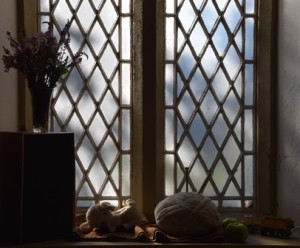
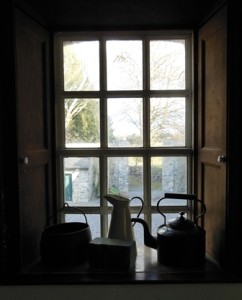
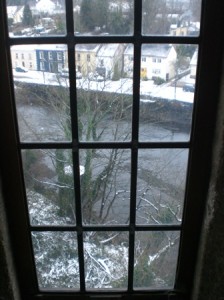
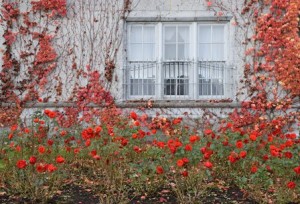
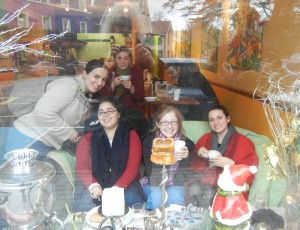
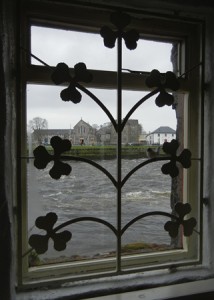
Of course I remember Dorothea looking out her window! And so many other of the lyrical moments of lookings-in and the lookings-out that you evoke so beautifully here. You give us in this posting double pleasure–your own lovely writing and insights and those of others.
A Blog with a view. Exquisite!